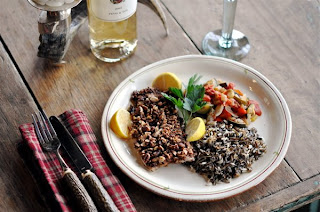 EVERY YEAR AROUND this time I start to get restless in anticipation of spring. One of my favorite rites of the season is the morel hunt, but for now all I can do is stare at the dried mushrooms from previous seasons in their glass mason jars—and then grab a handful to rehydrate for Steak and Morel Sauce…
EVERY YEAR AROUND this time I start to get restless in anticipation of spring. One of my favorite rites of the season is the morel hunt, but for now all I can do is stare at the dried mushrooms from previous seasons in their glass mason jars—and then grab a handful to rehydrate for Steak and Morel Sauce…
Steak with Morel Sauce
After making this sauce a couple times you’ll realize all it takes is a little improvisation in the kitchen to whip together an elegant and very tasty sauce every time, no matter what ingredients you have lying around.
For this one I used dried morels reconstituted in water, a splash of red wine not exceeding half a cup, beef stock, and just a touch of cream, but you could use white wine instead, or sherry, chicken or veggie stock, and other herbs (fresh tarragon pairs well with morels). Soy sauce is a nice touch. Always make sure to keep the liquid used to rehydrate morels as it’s a flavorful stock in its own right.
Most recipes will have you sauté the onion or garlic before adding the mushrooms, but this often leads to scorching the aromatics to an unpleasant bitterness. Mushrooms—and morels especially—take time to properly brown, so I add the shallots (or onions , garlic, etc.) after the morels have had some time in the pan.
2 steaks
2 oz dried morels (about 2 dozen) 
1 shallot, finely diced
2-3 tbsp butter
1/2 cup red wine
1 cup beef stock
1 tsp fresh thyme, chopped
2 oz heavy cream
salt and pepper
1. Rehydrate morels in warm water, just enough to cover, and set aside for 20 minutes. Salt and pepper steaks and allow to come to room temperature.
2. Pre-heat oven to 250 degrees. Melt 2 tablespoons butter in skillet over medium-high eat and cook steaks, a few minutes per side according to preference. Remove to a plate and keep warm in oven. Strain rehydrated morels, reserving liquid. Pat mushrooms dry on paper towel.
3. In same skillet over medium heat, add morels and another tablespoon of butter if necessary. Sauté a few minutes until morels begin to brown lightly on edges, then add diced shallots and cook together for another minute or two. De-glaze with red wine.
4. When wine is mostly evaporated, add some of both the beef stock and the mushroom stock, the fresh herbs, and a little heavy cream. Sauce should remain dark. Reduce and add more of both stocks and cream if necessary. When sauce reaches desired consistency, remove plate with steaks from oven and pour off accumulated juices into sauce, stirring. Spoon sauce and morels over steaks.


















